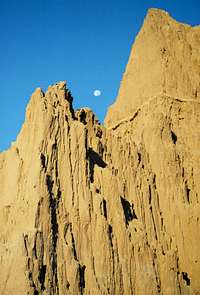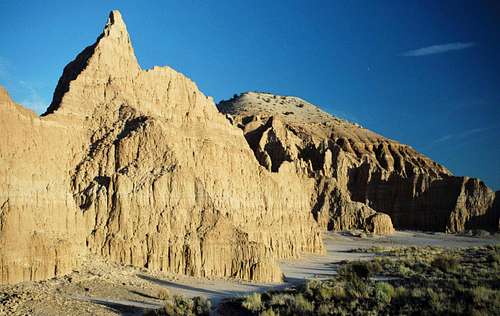-
 12797 Hits
12797 Hits
-
 95.67% Score
95.67% Score
-
 54 Votes
54 Votes
|
|
Area/Range |
|---|---|
|
|
37.81941°N / 114.41388°W |
|
|
Hiking, Canyoneering |
|
|
Spring, Summer, Fall, Winter |
|
|
4800 ft / 1463 m |
|
|
Why Go?
It's a long drive between Las Vegas and Great Basin National Park. Depending on how fast you like to go, it's 4-5 hours of driving mostly through sagebrush flats with a backdrop of parched-looking desert mountains. It's beautiful country to some people, myself included, possessed of the subtle beauty of endless skies and lonely places, but it's easy to understand why many people consider it maddeningly monotonous.
About halfway between the two destinations, however, is Cathedral Gorge State Park, a pocket of surreally beautiful badlands-style beauty. It is a small park, only 1608 acres, and it is hard to imagine spending more than one night there, but it makes a very nice way to break up a very long drive. Being a few hours (or less) from Las Vegas and the Utah towns of Cedar City and St. George, it also is a nice destination for a quick getaway all on its own.
An interesting historical note I found on Wikipedia: "At one time, Shakespearian plays were performed with the clay formations in the backdrop. The various naturally formed crevices were used as dressing rooms, and as a backstage where actors and actresses would prepare, awaiting their cue."
Geology, Natural History, and Climate
First, Cathedral Gorge is not a true gorge. Meadow Valley Wash and its tributaries cut through the area, but the ravines are not often much more than 50 feet deep. They do, however, become quite narrow in some places, resembling caves or slot canyons.
The park, established in 1935 and one of Nevada's four original state parks, protects a series of canyons, washes, and clay buttes and spires that are the remnants of an ancient lakebed from the Pliocene Era. A large freshwater lake covered the area about one million years ago. When the climate changed and the lake dried out, erosion started on the sediments exposed by the lake's disappearence. Rain and snowmelt cut the gullies and canyons that snake through the badlands seen here today.
Cathedral Gorge State Park is not really a place for summertime travelers. Temperatures are almost always above 90 degrees F and frequently top 100. It isn't humid, but 100 degrees is hot no matter how you look at it. And don't be fooled into thinking winter is a great time to go just because of the fact that the park is in a desert; the Great Basin Desert is a high desert, and while it's not a rarity to find very pleasant winter conditions, it's also quite common to encounter very cold temperatures, even below zero. Spring and fall, with warm days and cool nights, are the best times to visit.
Not much rain falls here, and most of it comes during the thunderstorms that are common in the summer. Hard, fast rains contribute to the constant shaping of this landscape and are, in fact, the main shapers. Do note that the clay soils here, when wet, become an impassable mess; avoid this area for a few days after any significant precipitation.
Getting There and What to Do
The park is one mile north of Panaca, which is at the intersection of U.S. 93 (Great Basin Highway) and NV 319. The park is about 160 miles from Las Vegas, about 115 miles from Ely, NV, and about 80 miles from Cedar City, UT.
The nearby towns of Panaca and Pioche have limited services.
Hiking
The park has six hiking trails, information for which can be found on the park's website. Two in particular stand out.
The first is the trail to Miller Point. This short trail (one mile RT) leads to an overlook with a panoramic view of the badlands. It also accesses some of the caving and canyoneering opportunities found here (see the next section).
The other is the 4-mile loop following washes through the badlands. This trail passes through some amazing formations that are especially dramatic in the light of sunrise/early morning and late afternoon/sunset.
Badlands often make fun destinations for scrambling, but my memory and the pictures on this page suggest that the formations here are too soft for that. Scrambling on the formations is both unsafe ecologically insensitive. There are some buttes and mesas in the park that are suitable for scrambling and off-trail hiking. Climbing these will only involve up to about 200 feet of elevation gain.
"Caving" and "Canyoneering"
Along the eastern edge of the gorge, by a picnic area accessed by a short spur road, are several tall formations with notable crevices at their bases. This is the "caves" area of the park. Some of the crevices are just two to three feet wide, and they can extend for 100 yards along twisting routes with side branches.
From Miller Point, at the northern end of the developed section of the park, there are several ravines that are so deep and narrow that they resemble slot canyons. Some of these slots have short caves carved from them, but some of the caves deep and long enough to be completely dark. Scrambling and climbing skills are necessary to explore this part of the park, as the soft rock often has been eroded into unusual surface patterns and sudden, significant elevation changes. Because the rock is so soft, this area is not conducive to technical canyoneering.
Red Tape
The park charges a day-use fee. Contact the park in advance at 775-728-4460 to find out current fee levels and accepted payment methods.
Camping
The park has a 22-site campground with grills, tables, and ramadas shading the tables. The campground has running water and flush toilets. There is a fee for camping, and all sites are first-come, first-served. Camping elsewhere within the park is prohibited.
External Links
More information:
Park website
Wikipedia
DesertUSA
American Southwest






